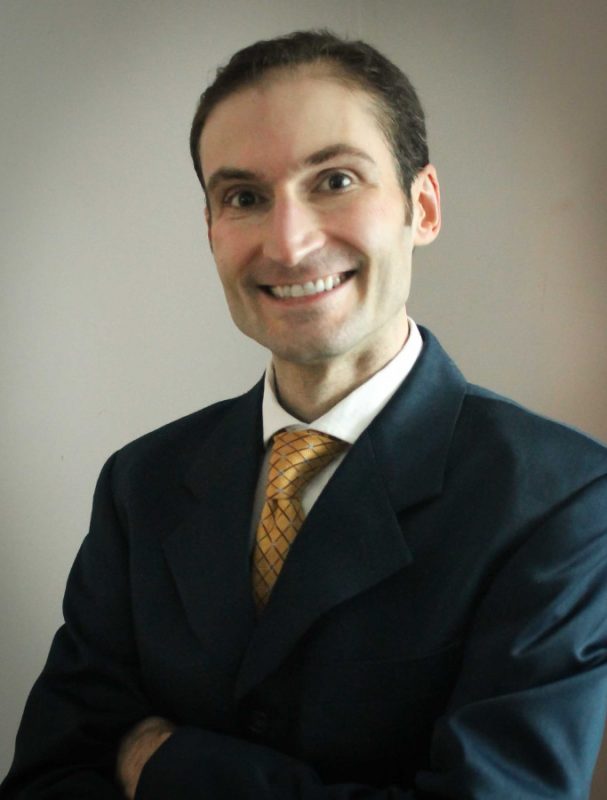
Steve Prinzivalli advised UMD’s American Meteorological Society on how to break into forecasting jobs on Wednesday March 14.
Gesturing to a synoptic map on a green screen is something of an acquired skill for broadcast meteorologists. But for Steve Prinzivalli, who has been setting up weather broadcast stations in his basement and plotting daily temperatures maximums since he was 8, it’s almost second nature at this point.
“Even back then, I had a fascination and passion for meteorology,” said Prinzivalli, as he pointed out the homemade weather symbols he had fashioned in a 1987 home video.
An historic snow storm in February 1983, along with supportive parents helped further fuel this weather passion into a meteorology degree from Penn State and an eventual career path as a broadcast meteorologist, a college professor, and a program manager.
On Wednesday, March 14, Prinzivalli, Storm Team 4 Meteorologist for WTOP and program manager for Earth Networks Weatherbug, advised the American Meteorological Society undergrads at University of Maryland on ways to break into various meteorology fields and maintain scientific integrity while doing so.
“What needs to come out of those internships— and I encourage anyone who is doing an internship—is you want to have a real live demo reel or tape…so that prospective employers can see that,” said Prinzivalli.
“This is going to be tough to swallow but you can write the prettiest cover letter or have the best resume in the world and that’s not going to land you the job,” said Prinzivalli, noting that the demo reel is “really everything.” “What I did put on these demo reels was a weathercast, a package live shot, and obviously contact information so people can get a hold of you.”
“You want to show your personality, showcase something that’s different,” Prinzivalli said.
Prinzivalli also noted the importance of keeping connections. “I want to stress the importance of colleagues …they might tell you about openings,” he said. Prinzivalli also practiced sending out his tapes “blindly” to stations he aspired to work in when he was first starting out. “I sent 30,40, 50 tapes out,” said Prinzivalli, “Send it out to every station, every geographical location.”
“Be realistic,” said Prinzivalli, “If you’re just coming out of college as I was many years ago, you may not end up getting a job immediately in the Washington, D.C., market.” Prinzivalli said students should be willing to travel far and work long overnight hours when they are breaking into the field.
After all, this is what Prinzivalli did as he took a series of jobs in Witchita, Kan., Binghamton, NY, and Dayton, Ohio at varying levels. He said the Wichita experience helped him prepare for seasonal severe weather peaks and Binghamton gave him the gift of “overage of every kind of weather.” Weekend shifts from 5 a.m. to midnight were exhausting and tiring, but these were typical of his time in Ohio.
In 2002, Prinzivalli took a break from broadcast to try his hand at something different —teaching meteorology to students at West Chester University. He noted that “if you’re going to be a teacher you really have to know your stuff.”
Senior atmospheric oceanic science major and American Meteorological Society Vice President Keenan Eure asked what was most difficult about each of Prinzivalli’s job transitions.
“Allow time—my transition from T.V. to academia was very abrupt,” said Prinzivalli, “I had to jump right in without any lesson plans. I think preparation is key—and do your homework on the field as much as you can… Find someone in that field.”
“I want to stress this to you that if you are interested in broadcast meteorology, be flexible and be willing to try new things and to roll with the punches,” said Prinzivalli, “You’re not just going to be a meteorologist, you might be pulled in for other opportunities and your boss is going to like that…this helps you learn new skills.”
Prinzivalli also espoused the importance of what interns do, by constructing weather graphics and broadcast reports.
Weatherbug allowed him to do “man on the street” video segments and other broadcast bits from a digital perspective. His time at Weatherbug also allowed him to apply for his current freelance meteorologist role at WTOP station, alongside his Earth Networks program manager position.
Prinzivalli advised students to ask themselves a couple of key questions before they decided to pursue a career in meteorology, including asking yourself if you are really passionate about weather, if you mind potentially holding a second job during when you’re just starting out and whether you mind being stopped in the grocery store for a forecast.
Senior atmospheric oceanic science major and American Meteorological Society President Troy Arcomano asked if you become the “go-to science guy” at a broadcast position. Prinzivalli affirmed that you become the “station scientist” and may be asked questions about astronomy for example with no training on the subject matter.
With this great responsibility comes integrity, according to Prinzivalli. He talked about the balance of ethics with forecasting when fielding junior atmospheric oceanic science major Jonathan Eun’s question.
“ When I was an intern at a Philly TV station there was a heat wave and the other TV stations were getting close to a 100 (degrees),” said Prinzivalli. A news manager came in to tell the chief meteorologist that he better forecast the same high temperature, according to Prinzivalli, “telling a scientist what he should be forecasting.” The chief meteorologist decided to stick with his forecasted 95, said Prinzivalli, noting this moment as defining in teaching him about the balance of conveying accurate information and capturing an audience.
“As you’re asked to forecast farther in the future, give them what you know. How can we compromise?” Prinzivalli asked students.
His last piece of advice to students applying for jobs was: “Anything can be overcome—don’t sell yourself short.”
